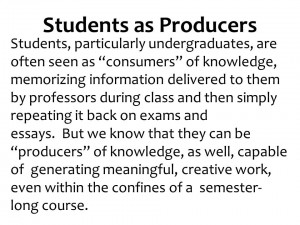Self-Authoring Community Activism:
Women & Gender Studies Students as Producers
by Nancy Chick, CFT Assistant Director
The CFT’s theme this year, “Students as Producers,” has given me the opportunity to talk with some talented and thoughtful colleagues across campus. On October 24, I brought together three of them to have a conversation on teaching about “Producing, Performing, & Creating Learning across the Humanities: Models of Generative Learning Assignments.” Their ideas were so rich that I’m devoting separate blog posts to each of them. Up first, Rory Dicker.

Rory Dicker (Women’s and Gender Studies Program, English Department) shared her activism project from WGS 150: Sex and Gender in Everyday Life. In this course, students learn about the social constructions of gender and gender roles, and in the process they encounter many illustrative examples of inequality. Rory, like others who teach courses that acknowledge inequality, knows that this experience can be “dispiriting,” as she explains in her assignment instructions. Rather than leaving students with the impression that there are only problems and no solutions, that theory without action is sufficient, and, more importantly, that the students are powerless in the face of social injustice, Rory assigns a project that gives students a way to explore and express their power within a problem they care about. Samples include “Dress Down Days” that draw attention away from external definitions of beauty, hands-on workshops in activities typically not taught to women (auto repair), discussion groups on violence against women, and various awareness activities with stickers, buttons, flyers, and the like.
To support the values of collaborative work and of thinking locally—and to keep the work manageable—the projects are conceptualized, planned, and carried out by well-structured groups and focused on the immediate campus community. She encourages students to “Be creative” (emphasis in original), to address “a need that hasn’t been met or a population that hasn’t been served,” and to design a project that effectively reaches audiences that might actually effect some change. She supports their work by offering help, telling them she wants their projects “to be exciting, not agonizing.” Students are using their own voices, their own authority, but they aren’t without support if needed.
The group assignment’s components include the following:

- a proposal, which gives Rory the chance to offer early feedback and guidance, if needed;
- a presentation to the class; and
- a portfolio documenting their project from start to finish, including pictures, notes, newspaper articles, video and audio recordings as relevant, copies of relevant communications, and any other archivable material that captures the work of the project.
Students also write individual self-assessments, reflecting on both the processes they used (“how and why you decided to do this particular project, how you knew that this work was needed or would be useful, and how you performed your activism,” as well as their rationale for designing their surveys, brochures, etc., as they did) and their lessons learned in applying what they’ve been learning to the Vanderbilt community. While the project itself may effect some change in the community, these metacognitive components–in which students reflect on and evaluate their thinking and learning–ensure an internal change (learning) within the students themselves.
What do these students “produce”? Materially, they produce a portfolio, but Rory is quick to point out that the portfolios merely document the real work they’ve created: their own self-authored action in the community based on what they’ve been learning, the changes they effect, and their own emerging identities as agents within a larger social system.
—
For additional ideas on alternative projects for students in the humanities, check out the CFT guide “Beyond the Essay: Making Student Thinking Visible in the Humanities.”
The next post will feature Nathalie Dieu-Porter’s French students’ work.

Leave a Response